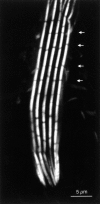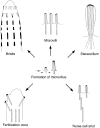F-actin bundles are derivatives of microvilli: What does this tell us about how bundles might form?
- PMID: 10629213
- PMCID: PMC2156212
F-actin bundles are derivatives of microvilli: What does this tell us about how bundles might form?
Figures



References
-
- Beckerle M.C. Spatial control of actin filament assemblylessons from Listeria . Cell. 1998;95:741–748. - PubMed
-
- Ezzell R.M., Chafel M.M., Matsudaira P.T. Differential localization of villin and fimbrin during development of the mouse visceral endoderm and intestinal epithelium. Development. 1989;106:407–419. - PubMed
Publication types
MeSH terms
Substances
Grants and funding
LinkOut - more resources
Full Text Sources
Molecular Biology Databases
